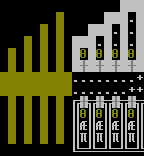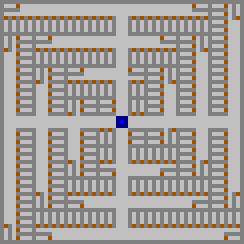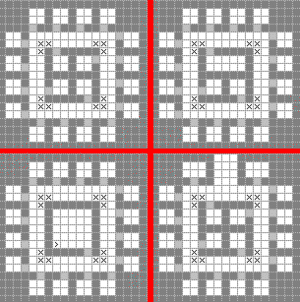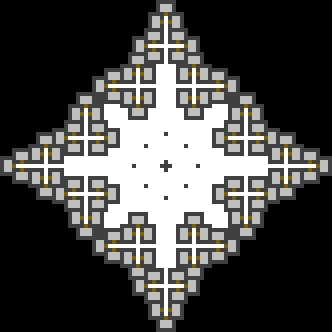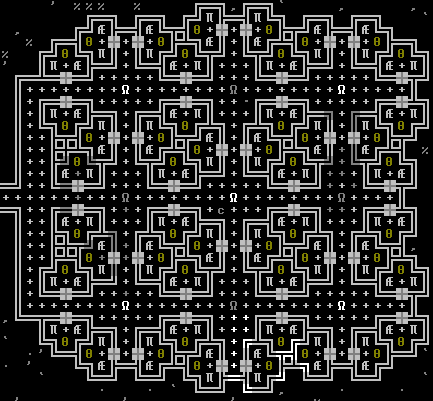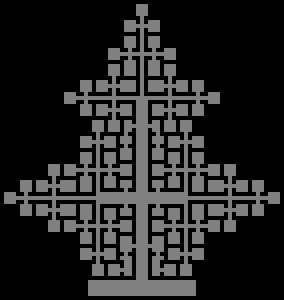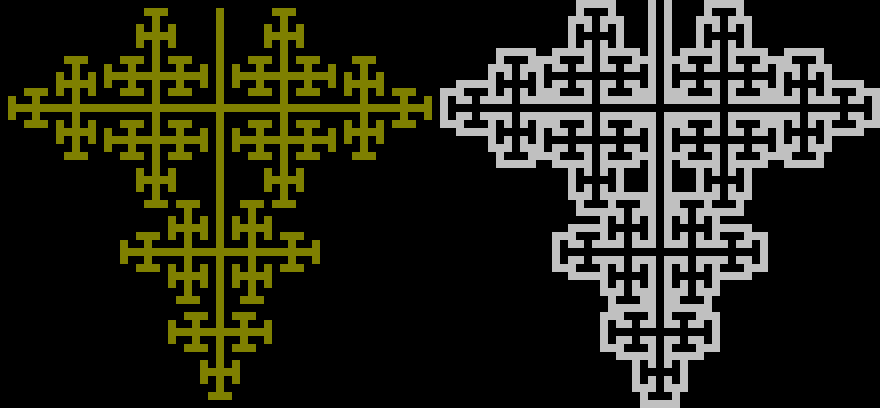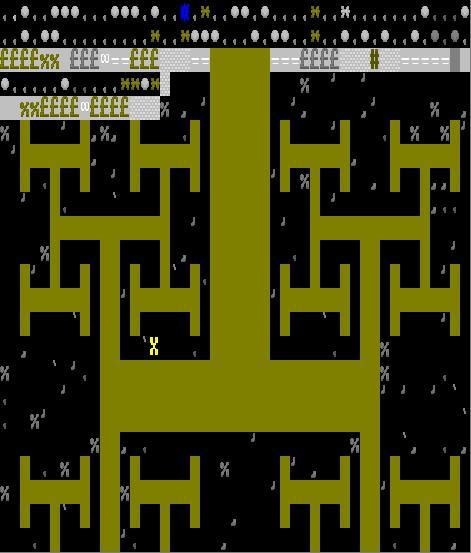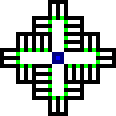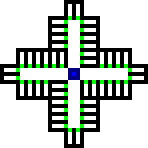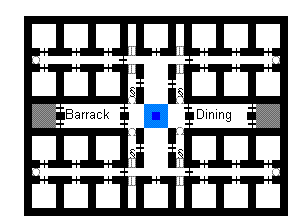- v50 information can now be added to pages in the main namespace. v0.47 information can still be found in the DF2014 namespace. See here for more details on the new versioning policy.
- Use this page to report any issues related to the migration.
Difference between revisions of "40d:Bedroom design"
(Updating link to forum post - other one was 404) |
ThunderClaw (talk | contribs) (Added a very utilitarian but effective bedroom design) |
||
| Line 162: | Line 162: | ||
[[image:VaniverGreek32.png]] | [[image:VaniverGreek32.png]] | ||
[[image:VaniverGreek48.png]] | [[image:VaniverGreek48.png]] | ||
| + | |||
| + | |||
| + | ==Decentralized Living== | ||
| + | In larger fortresses, one of the bigger problems is traffic. Dwarves have a tendency to all get hungry, thirsty, and tired in waves, and a crowd of 50 of them storming your centralized food stockpiles, one big dining room, and dormitory tunnels can cause a lot of lost time while the hordes shuffle by eachother. A good solution to this is decentralized archetecture, incorporating most of the essentials of every day life into numerous smaller areas. | ||
| + | |||
| + | [[image:Living.GIF]] | ||
| + | |||
| + | |||
| + | In this image, the access stairwell (blue fields in the center), spread out in all directions to a public barracks and dining room for poorer dwarves on the left and right to 3x3 private rooms to the top and bottom. The design allows for two small stockpiles of food (gray fields) to minimize the walk to a dining hall. | ||
| + | |||
| + | There's also built-in areas for impressive things like statues and cages (for zoos) to keep dwarves admiring your handiwork. The 3x3 rooms are easy to get up to Decent or higher to keep your most useful dwarves happy as clams. If you want an even more decentralized and calm traffic pattern, put tables and chairs in all the private rooms; dwarves will prefer to eat in their quarters. The walls between the doors leading to the Barrack and Dining Room allow for 2 entrances and 2 exits to each predictably higher-traffic room while leaving a pillar of rock for an engraving. The main corridor also allows you to branch off into 4 restraints per floor in a private 1x2 prison. Since it's flanked by an animal cage and a statue and in an area you want smoothed and engraved to begin with, it gives prisoners a leg upon their happiness immediately and -- once again -- prevents traffic jams from convicts being brought food and water in larger prisons. | ||
| + | |||
| + | Another option for maximizing traffic throughput is to put a 1x3 line of upward stairwells on one end of the blue field, and a 1x3 line of downward stairwells on the other. This simulates a 3-wide vertical corridor without the safety risks of up/down stairwells. | ||
| + | |||
| + | You may also, at your discretion, knock out the statues and cages near the stairwell to make the entire plan a little more compact (though you lose the easy prisons in this case). This plan can stretch on the x axis as much as you like, but note that the 1 wide corridors leading to individual rooms can get crowded if more than 10 dwarves are living along each one. Even with the given layout, though, one floor supports 26 private rooms and as many as 14 public beds. This works out quite nicely since one floor is enough to handle most immigrant waves, while existing floors' public beds can handle a decent amount of overflow. The public barrack rooms can also be converted into prisons very easily (just put chains next to every bed) if you decide not to go with the main design. | ||
{{Buildings}} | {{Buildings}} | ||
Revision as of 16:14, 9 October 2008
There are many ways to design the layout of bedrooms. Designs must consider simplicity and ease of designating, efficiency, and aesthetics. The ability to modify the design to enlarge, improve, or add rooms can be important as well. Proximity of the rooms to noise should also be considered.
Many of the designs shown here were taken from this forum post.
Plain square design
If it is 2×2, 3×3 or more, square designs are probably the first choice of many players. Easy to plan, easy to put in place, this kind of design is one of the best when the player value his playing time instead of the overall layout of his fortress. While square designs are easy to reproduce en masse, most are not optimized either for beauty or space efficiency, two aspects that other designs excel at.
Line design
Line designs have the advantage of being very space efficient and very adaptative. From 1×1 to 1×4 and longer, it can fit almost anywhere, can be upgraded later on as long as you have the space behind your first original line and do not need excessive corridor space for the bedroom access. Simply dig a few lines out of an access tunnel already in use in your fortress and voila, you have new living quarters. This kind of minimalistic design is perfect for when the economy kicks in, as it can be adapted in a flash for any kind of low wage citizen.
THLawrence's Living Pods
Apartment Complex:
|
|
An editor has asked for quick deletion of this article. The editor's reason for asking for deletion is: ╔
More details: ═
If you think this article should not be deleted, please add {{Wait}} below this message, and then say why on this article's talk page. Please do not remove this notice from ═s that you have ╦ yourself. Administrators, remember to check what links here, the page history (last edit), and the page log, before deletion. |
|
|
An editor has asked for quick deletion of this article. The editor's reason for asking for deletion is: ╠
More details: ═
If you think this article should not be deleted, please add {{Wait}} below this message, and then say why on this article's talk page. Please do not remove this notice from ═s that you have ╬ yourself. Administrators, remember to check what links here, the page history (last edit), and the page log, before deletion. |
Lobby:
|
|
An editor has asked for quick deletion of this article. The editor's reason for asking for deletion is: ╔
More details: ═
If you think this article should not be deleted, please add {{Wait}} below this message, and then say why on this article's talk page. Please do not remove this notice from ═s that you have ╦ yourself. Administrators, remember to check what links here, the page history (last edit), and the page log, before deletion. |
|
|
An editor has asked for quick deletion of this article. The editor's reason for asking for deletion is: ╠
More details: ═
If you think this article should not be deleted, please add {{Wait}} below this message, and then say why on this article's talk page. Please do not remove this notice from ═s that you have ╣ yourself. Administrators, remember to check what links here, the page history (last edit), and the page log, before deletion. |
This design is compact and allows for a large number of rooms. Each room has 3 tiles and a door. To add the apartment complex build it one level above or below the lobby. The design can be stretched to make the rooms 3x2 or 3x3 depending on your preference. Though not as impressive as the fractal patterns it is very efficient in that it can allow for large numbers of dwarves to easily access the main hallway.
GnomeChomsky's Tessellated Apartments
|
|
An editor has asked for quick deletion of this article. The editor's reason for asking for deletion is: \
More details: \
If you think this article should not be deleted, please add {{Wait}} below this message, and then say why on this article's talk page. Please do not remove this notice from \s that you have \ yourself. Administrators, remember to check what links here, the page history (last edit), and the page log, before deletion. |
|
|
An editor has asked for quick deletion of this article. The editor's reason for asking for deletion is: \
More details: \
If you think this article should not be deleted, please add {{Wait}} below this message, and then say why on this article's talk page. Please do not remove this notice from ║s that you have . yourself. Administrators, remember to check what links here, the page history (last edit), and the page log, before deletion. |
|
|
An editor has asked for quick deletion of this article. The editor's reason for asking for deletion is: \
More details: \
If you think this article should not be deleted, please add {{Wait}} below this message, and then say why on this article's talk page. Please do not remove this notice from \s that you have ╚ yourself. Administrators, remember to check what links here, the page history (last edit), and the page log, before deletion. |
|
|
An editor has asked for quick deletion of this article. The editor's reason for asking for deletion is: \
More details: \
If you think this article should not be deleted, please add {{Wait}} below this message, and then say why on this article's talk page. Please do not remove this notice from \s that you have \ yourself. Administrators, remember to check what links here, the page history (last edit), and the page log, before deletion. |
|
|
An editor has asked for quick deletion of this article. The editor's reason for asking for deletion is: \
More details: \
If you think this article should not be deleted, please add {{Wait}} below this message, and then say why on this article's talk page. Please do not remove this notice from ║s that you have . yourself. Administrators, remember to check what links here, the page history (last edit), and the page log, before deletion. |
|
|
An editor has asked for quick deletion of this article. The editor's reason for asking for deletion is: \
More details: \
If you think this article should not be deleted, please add {{Wait}} below this message, and then say why on this article's talk page. Please do not remove this notice from \s that you have ╚ yourself. Administrators, remember to check what links here, the page history (last edit), and the page log, before deletion. |
Access can be from above and/or below by the stairs, or a hallway can be run into the dining room level by removing the bedroom at one of the cardinal points. This design can be repeated as far as desired in the X, Y, and Z directions.
High density single floor housing
This fractal-inspired design combines space efficiency with wider access hallways to alleviate traffic. Stairs are placed in the middle, and the design can expand indefinitely. To decrease the size, remove the outermost perimeter hallway, and all connected bedrooms. To increase the size, use the picture as a guide and follow the same radial pattern.
| Size | Capacity | Max walk distance from center |
|---|---|---|
| 29x29 tiles | 48 dwarves | 23 steps |
| 45x45 tiles | 120 dwarves | 39 steps |
| 61x61 tiles | 224 dwarves | 55 steps |
| 77x77 tiles | 360 dwarves | 71 steps |
Shaft design
The Shaft design allows various options for entry direction and central "shaft" use. The central shaft may be altered to create bedrooms, dining rooms and offices for minor nobles, "deluxe" bedrooms, hospital beds, or simply more bedrooms. The design can easily accomodate several different room sizes while maintaining efficiency. However, the design utilizes Z-levels for efficiency, and you must build several levels of Shaft designs to accomodate a fully grown fortress.
The Shaft design can fit 20 2x2 rooms, or 30 1x1 rooms.
Fractal designs
Betting on design beauty and on geometrical symmetry first, fractal designs can also be at the same time very space and walk efficient. They however require a lot of time and space both to plan and execute and are most likely out of reach of all but the most serious players. Most players however agree to say that they are the most incredible of all the designs around, if not the for the sheer challenge of successfully executing something as complex, then for the extra touch it give to the whole fortress as a whole once it is done.
Vaniver's Greek Cross design
Minimizing walking distances requires good use of vertical space. This plan is simple, scalable, and only takes up a few floors- 6 if you have 32 per floor, 4 if you have 48. The maximum walking distance should be less than 20 (I'm not sure how much movement stairs take).
Decentralized Living
In larger fortresses, one of the bigger problems is traffic. Dwarves have a tendency to all get hungry, thirsty, and tired in waves, and a crowd of 50 of them storming your centralized food stockpiles, one big dining room, and dormitory tunnels can cause a lot of lost time while the hordes shuffle by eachother. A good solution to this is decentralized archetecture, incorporating most of the essentials of every day life into numerous smaller areas.
In this image, the access stairwell (blue fields in the center), spread out in all directions to a public barracks and dining room for poorer dwarves on the left and right to 3x3 private rooms to the top and bottom. The design allows for two small stockpiles of food (gray fields) to minimize the walk to a dining hall.
There's also built-in areas for impressive things like statues and cages (for zoos) to keep dwarves admiring your handiwork. The 3x3 rooms are easy to get up to Decent or higher to keep your most useful dwarves happy as clams. If you want an even more decentralized and calm traffic pattern, put tables and chairs in all the private rooms; dwarves will prefer to eat in their quarters. The walls between the doors leading to the Barrack and Dining Room allow for 2 entrances and 2 exits to each predictably higher-traffic room while leaving a pillar of rock for an engraving. The main corridor also allows you to branch off into 4 restraints per floor in a private 1x2 prison. Since it's flanked by an animal cage and a statue and in an area you want smoothed and engraved to begin with, it gives prisoners a leg upon their happiness immediately and -- once again -- prevents traffic jams from convicts being brought food and water in larger prisons.
Another option for maximizing traffic throughput is to put a 1x3 line of upward stairwells on one end of the blue field, and a 1x3 line of downward stairwells on the other. This simulates a 3-wide vertical corridor without the safety risks of up/down stairwells.
You may also, at your discretion, knock out the statues and cages near the stairwell to make the entire plan a little more compact (though you lose the easy prisons in this case). This plan can stretch on the x axis as much as you like, but note that the 1 wide corridors leading to individual rooms can get crowded if more than 10 dwarves are living along each one. Even with the given layout, though, one floor supports 26 private rooms and as many as 14 public beds. This works out quite nicely since one floor is enough to handle most immigrant waves, while existing floors' public beds can handle a decent amount of overflow. The public barrack rooms can also be converted into prisons very easily (just put chains next to every bed) if you decide not to go with the main design.
| Rooms | |
|---|---|
| Furniture |
Animal trap • Anvil • Armor stand • Bed • Bin • Bucket • Cabinet • Cage • Coffin • Container • Restraint • Seat • Statue • Table • Weapon rack |
| Access | |
| Constructions | |
| Machine & Trap parts |
Axle • Gear assembly • Millstone • Screw pump • Water wheel • Windmill • Lever • Pressure plate • Trap • Support |
| Other Buildings | |
| Related Articles | |

